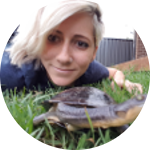-
Member Login
- Home
- About
- Institute Groups
- Membership
- Events
- News & Publications
- Institute Programs
- Resources
- Jobs Board
- Contact Us
- Site Info
Mel McGregor
Mel McGregor
Abstract | Exploring the unexpected: The benefits of understanding non-target species use of fauna passages
Wildlife ecology is a discipline in which few of many variables can be controlled, are consistent, or indeed predictable in most instances; it is, often, full of surprises.
Road ecology is no different, and in the quest to build the perfect road crossing structure, unexpected discoveries lurk around every corner. Road ecology research has often based the ‘success’ of any given fauna passage on features such as the structure and function of the design, as well as consideration of the ecological requirements of target fauna communities.
Many studies to date have investigated the use of fauna passages (of a multitude of designs) by target species, most often larger mammals, with relatively few assessing taxa such as reptiles, birds, amphibians and bats. The overrepresentation of mammal-centric literature demonstrates that many researchers either do not expect other taxa to use fauna crossings, or that their benefit to a more diverse range of taxa – ‘non-target species’ - has simply not been considered.
Fauna passages designed to provide opportunity to broad non-target species, by providing replicated habitat and niche diversity as critical design elements, have, however, been shown to be quite effective. The importance of a more holistic approach to the broader wildlife community, when implementing fauna crossings, may be an ideal way to counteract surprises inherent in the ecological discipline
Recognising the diversity and the ecological requirements of the local non-target fauna communities should be considered prior to implementation, to ensure the broadest available opportunity for the widest array of species. Recognising that wildlife persistence is reliant upon a larger system may encourage improved fauna passage design.
This, in turn, will support the use of fauna passages by those ‘surprising’ species, and encourage ecological safety and persistence where roads impact the natural landscape.
Bio | Mel McGregor
 Mel is a wildlife ecologist with a keen interest investigating questions arising with the conflict between urbanisation and the natural environment. Her PhD focused on the Compton Road fauna array, south of Brisbane, and whether it is used by non-target species (including bats, small mammals and herptiles). She has a particularly soft spot for reptiles, and gets excited about any wildlife that can be photographed, captured, measured, studied, cuddled or wrestled. At present she is working in Melbourne as an ecological consultant; however, she continues to force her way into research/ecology gatherings (just like ANET), supported by her PhD supervisor (Professor Darryl Jones), to hopefully one day, wriggle her way back into wildlife ecology research.
Mel is a wildlife ecologist with a keen interest investigating questions arising with the conflict between urbanisation and the natural environment. Her PhD focused on the Compton Road fauna array, south of Brisbane, and whether it is used by non-target species (including bats, small mammals and herptiles). She has a particularly soft spot for reptiles, and gets excited about any wildlife that can be photographed, captured, measured, studied, cuddled or wrestled. At present she is working in Melbourne as an ecological consultant; however, she continues to force her way into research/ecology gatherings (just like ANET), supported by her PhD supervisor (Professor Darryl Jones), to hopefully one day, wriggle her way back into wildlife ecology research.
We acknowledge and value the rights and interests of Indigenous Peoples in the protection and management of environmental values through their involvement in decisions and processes, and the application of traditional Indigenous knowledge.

